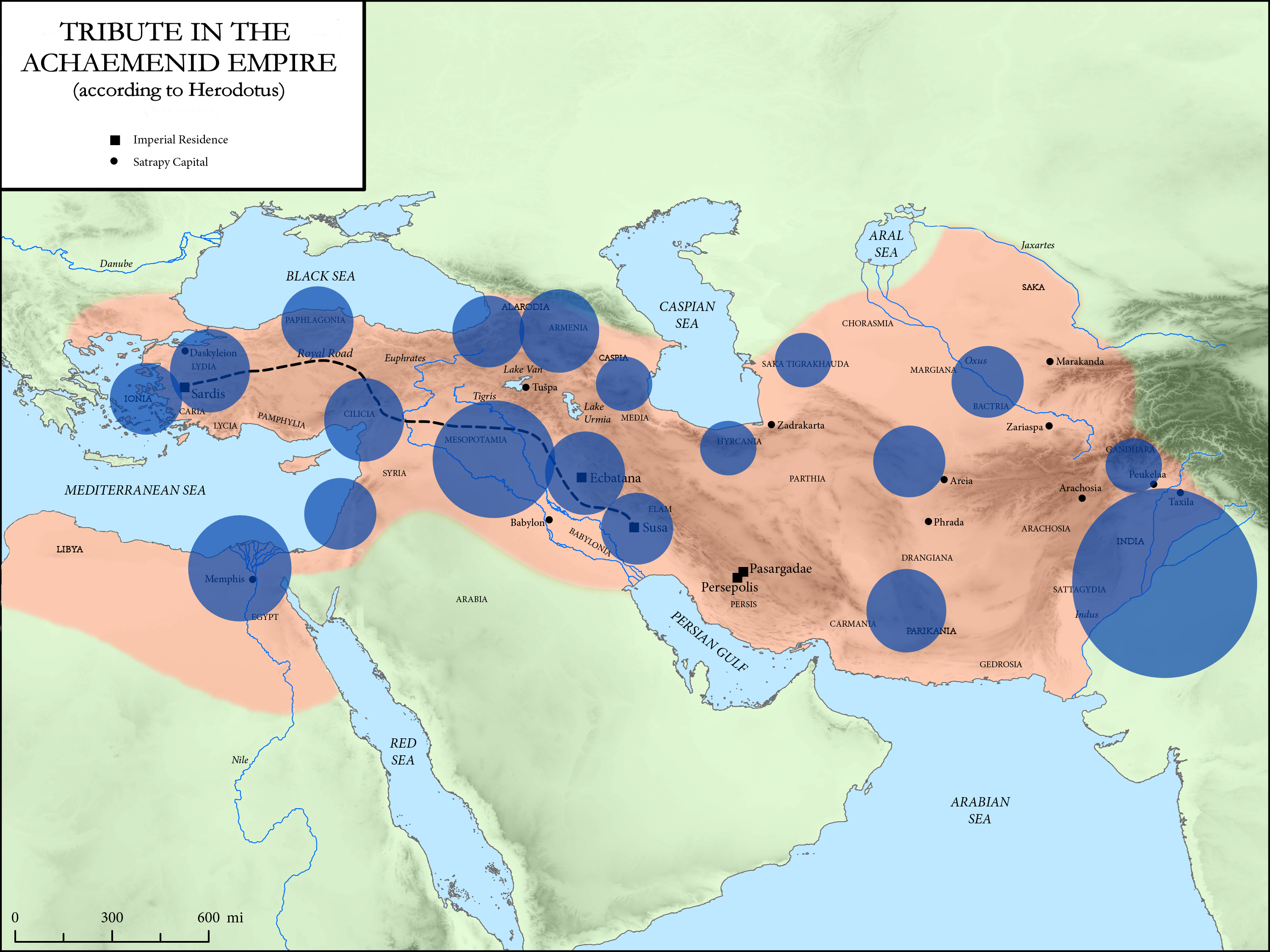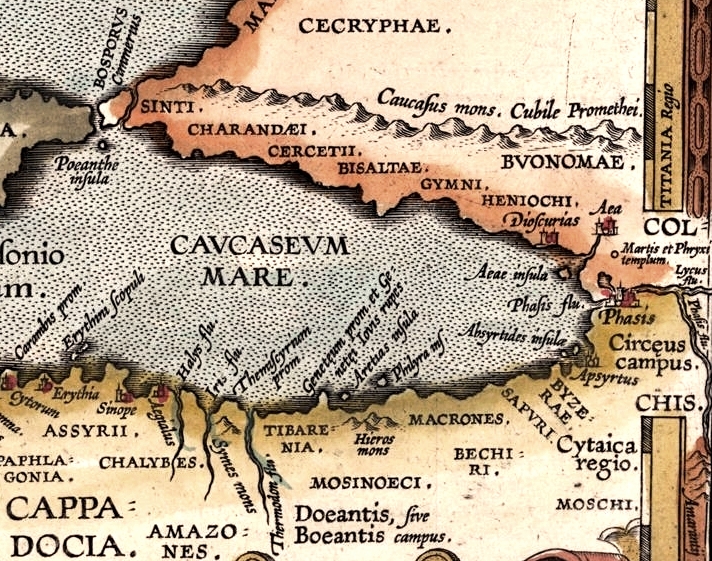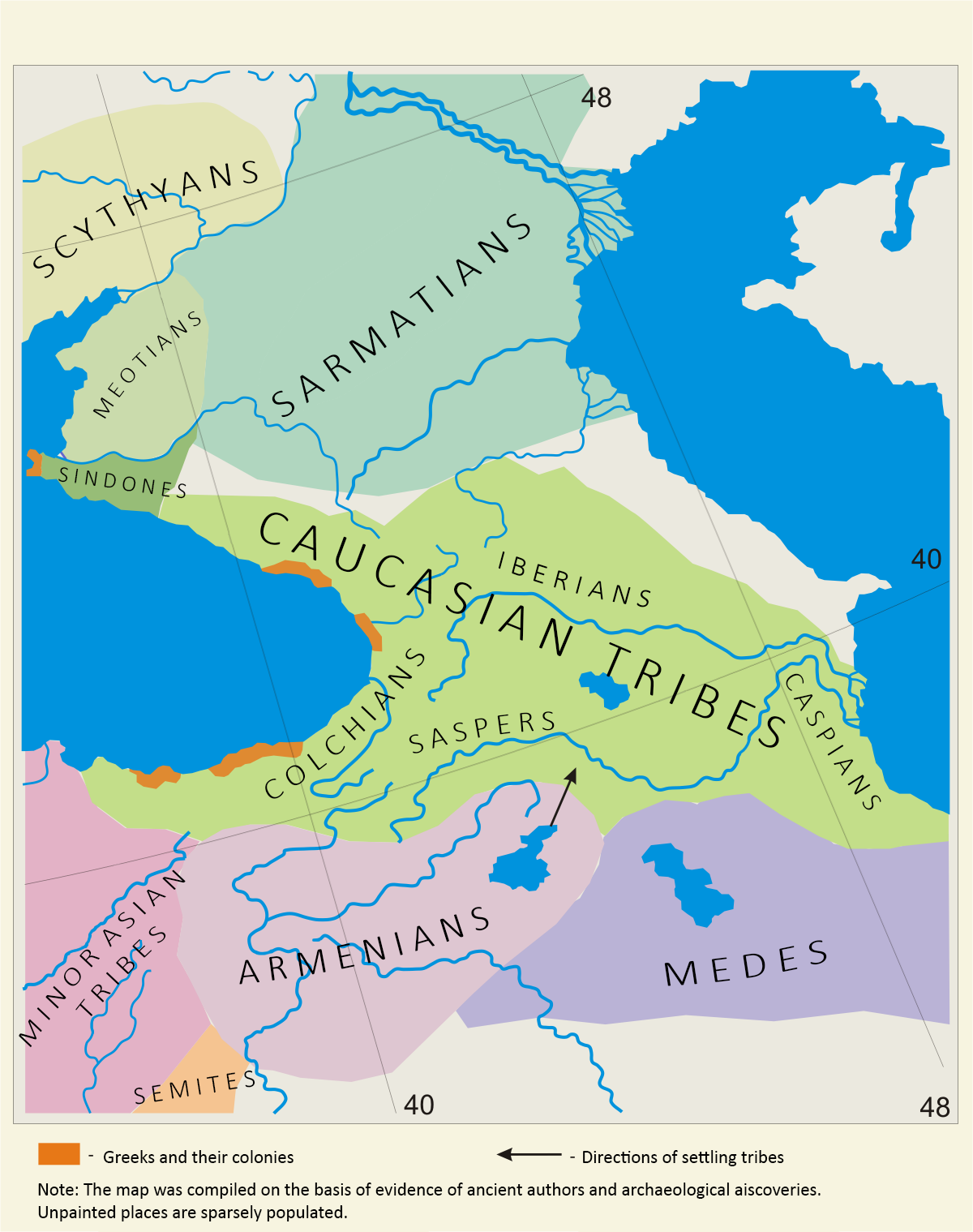|
Macrones
The Macrones ( ka, მაკრონები) ( grc, Μάκρωνες, ''Makrōnes'') were an ancient Colchian tribe in the east of Pontus, about the Moschici Mountains (modern Yalnizçam Dağlari, Turkey). The name is allegedly derived from the name of Kromni valley ( Κορούμ, located 13 km north-east of Gümüşhane) by adding Kartvelian ma- prefix which denotes regional descendance. History The Macrones are first mentioned by Herodotus (c. 450 BC), who relates that they, along with Moschi, Tibareni, Mossynoeci, and Marres, formed the nineteenth satrapy within the Achaemenid Persian Empire and fought under Xerxes I. There are many other subsequent references to them in the Classical accounts. Xenophon (430-355 BC) places them east of Trapezus (modern Trabzon, Turkey). They are described as a powerful and wild people wearing garments made of hair, and as using in war wooden helmets, small shields of wicker-work, and short lances with long points. Strabo (xii.3.18) ... [...More Info...] [...Related Items...] OR: [Wikipedia] [Google] [Baidu] |
Marres
The Mares ( ka, მარები ) were an ancient Colchian tribe. They entered ancient history with the writings of Hecataeus of Miletus. He gives a brief description of the tribe and mentions that they lived between closely akin Colchian tribal groups Macrones and Mossynoeci. They inhabited the southeast periphery of the Black Sea, more precisely the mountains of Northeast Anatolia, which constitutes, along with South Caucasus, a proposed homeland of the Kartvelian languages and the convergent territory in which they were molded into a nation. According to Herodotus, they had the same leader as the Colchians, who were the larger entity created through a process of political consolidation and amalgamation of tribes. After the rapid rise of Achaemenid Empire, they were incorporated into the XIX Satrapy, along with other Colchian tribes Mushki, Tibareni, Macrones and Mossynoeci Mossynoeci (Georgian: მოსინიკები, grc, Μοσσύνοικοι, , modern Greek ... [...More Info...] [...Related Items...] OR: [Wikipedia] [Google] [Baidu] |
Pontus (region)
Pontus or Pontos (; el, Πόντος, translit=Póntos, "Sea") is a region on the southern coast of the Black Sea, located in the modern-day eastern Black Sea Region of Turkey. The name was applied to the coastal region and its mountainous hinterland (rising to the Pontic Alps in the east) by the Greeks who colonized the area in the Archaic period and derived from the Greek name of the Black Sea: ''(')'', "Hospitable Sea", or simply ''Pontos'' () as early as the Aeschylean ''Persians'' (472 BC) and Herodotus' ''Histories'' (circa 440 BC). Having originally no specific name, the region east of the river Halys was spoken of as the country ''()'', lit. "on the uxinosPontos", and hence it acquired the name of Pontus, which is first found in Xenophon's ''Anabasis (Xenophon), Anabasis'' (). The extent of the region varied through the ages but generally extended from the borders of Colchis (modern western Georgia (country), Georgia) until well into Paphlagonia in the west, with ... [...More Info...] [...Related Items...] OR: [Wikipedia] [Google] [Baidu] |
Sperata
''Sperata'' is a genus of bagrid catfishes. Species There are currently six recognized species in this genus: * ''Sperata acicularis'' Ferraris & Runge, 1999 * ''Sperata aor'' ( F. Hamilton, 1822) - Long-whiskered catfish * ''Sperata aorella'' ( Blyth, 1858) *''Sperata aorides'' *''Sperata lamarrii'' * ''Sperata seenghala'' (Sykes, 1839) - Giant river-catfish Distribution Species of ''Sperata'' are found in southern Asia from Afghanistan to Thailand where they are found in a wide variety of water bodies. Relationship to humans At least two of the ''Sperata'' species (''S. aor'' & ''S. seenghala'') are sport fish as well as being important food fish Food is any substance consumed by an organism for nutritional support. Food is usually of plant, animal, or fungal origin, and contains essential nutrients, such as carbohydrates, fats, proteins, vitamins, or minerals. The substance is ingest .... References Bagridae Fish of Asia Catfish genera Freshwater fish ... [...More Info...] [...Related Items...] OR: [Wikipedia] [Google] [Baidu] |
Mushki
The Mushki (sometimes transliterated as Muški) were an Iron Age people of Anatolia who appear in sources from Assyria but not from the Hittites. Several authors have connected them with the Moschoi (Μόσχοι) of Greek sources and the Georgian tribe of the Meskhi. Josephus Flavius identified the ''Moschoi'' with the Biblical Meshech. Two different groups are called ''Muški'' in Assyrian sources ( Diakonoff 1984:115), one from the 12th to the 9th centuries BC near the confluence of the Arsanias and the Euphrates ("Eastern Mushki") and the other from the 8th to the 7th centuries BC in Cappadocia and Cilicia ("Western Mushki"). Assyrian sources clearly identify the Western Mushki with the Phrygians, but later Greek sources then distinguish between the Phrygians and the Moschoi. Identification of the Eastern Mushki with the Western Mushki is uncertain, but it is possible that at least some of the Eastern Mushki migrated to Cilicia in the 10th to the 8th centuries BC. Although ... [...More Info...] [...Related Items...] OR: [Wikipedia] [Google] [Baidu] |
Trabzon
Trabzon (; Ancient Greek: Tραπεζοῦς (''Trapezous''), Ophitic Pontic Greek: Τραπεζούντα (''Trapezounta''); Georgian: ტრაპიზონი (''Trapizoni'')), historically known as Trebizond in English, is a city on the Black Sea coast of northeastern Turkey and the capital of Trabzon Province. Trabzon, located on the historical Silk Road, became a melting pot of religions, languages and culture for centuries and a trade gateway to Persia in the southeast and the Caucasus to the northeast. The Venetian and Genoese merchants paid visits to Trabzon during the medieval period and sold silk, linen and woolen fabric. Both republics had merchant colonies within the city – Leonkastron and the former "Venetian castle" – that played a role to Trabzon similar to the one Galata played to Constantinople (modern Istanbul). Trabzon formed the basis of several states in its long history and was the capital city of the Empire of Trebizond between 1204 and 1461. Durin ... [...More Info...] [...Related Items...] OR: [Wikipedia] [Google] [Baidu] |
Persian Empire
The Achaemenid Empire or Achaemenian Empire (; peo, wikt:𐎧𐏁𐏂𐎶, 𐎧𐏁𐏂, , ), also called the First Persian Empire, was an History of Iran#Classical antiquity, ancient Iranian empire founded by Cyrus the Great in 550 BC. Based in Western Asia, it was contemporarily the List of largest empires, largest empire in history, spanning a total of from the Balkans and ancient Egypt, Egypt in the west to Central Asia and the Indus River, Indus Valley in the east. Around the 7th century BC, the region of Persis in the southwestern portion of the Iranian plateau was settled by the Persians. From Persis, Cyrus rose and defeated the Medes, Median Empire as well as Lydia and the Neo-Babylonian Empire, marking the formal establishment of a new imperial polity under the Achaemenid dynasty. In the modern era, the Achaemenid Empire has been recognized for its imposition of a successful model of centralized, bureaucratic administration; its multicultural policy; building comp ... [...More Info...] [...Related Items...] OR: [Wikipedia] [Google] [Baidu] |
Districts Of The Achaemenid Empire
Herodotus divided the Achaemenid Empire into 20 districts for the purpose of tribute payments. The following is a description of the ethnic makeup of the districts and the amount they paid in taxes, translated from Herodotus' '' Histories''. Accounting units The quantities of silver are given in Babylonian talent (1 Babylonian talent = about 30.3 kg), while the quantities of gold (India only) are given in Euboïc/Euboean talent (1 Euboïc talent = about 26 kg). Only the Hindush paid in gold, the exchange rate of gold to silver being 1 to 13 by weight at the time of Herodotus. Tax districts The order of the districts given here follows Herodotus, ''Histories'', III.90–94. In hellenocentric way it starts with Ionia and Mysia. The official Persian order of the provinces, as devised under Darius I in 518 BCE, was different and started from the Empire's capital: 1. Media, 2. Susa, etc.Hermann Bengtson, Vladimir Milojčić (ed.), ''Grosser Historischer Weltatlas'', Erster T ... [...More Info...] [...Related Items...] OR: [Wikipedia] [Google] [Baidu] |
Mossynoeci
Mossynoeci (Georgian: მოსინიკები, grc, Μοσσύνοικοι, , modern Greek ', "dwellers in wooden towers") is a name that the Greeks of the Euxine Sea (Black Sea) applied to the peoples of Pontus, the northern Anatolian coast west of Trebizond. The Mossynoeci were believed to be of proto-Georgian. Herodotus Writing soon after 430 BCE, Herodotus in Book 3 cites the Mossynoeci, along with the Moschoi, Tibareni The Tibareni ( ka, ტიბარენები, Tibarenebi; Greek: Τιβαρηνοί and Τιβαρανοί;) were a people residing on the coast of ancient Pontus referred to in Herodotus, Xenophon, Strabo and other classical authors. The Ti ..., the Macrones and Marres as comprising the Districts of the Achaemenid Empire, 19th satrapy established by Darius the Great, Darius of Persia. The satrapy as a whole was to yield three hundred talents. The Mossynoeci are also mentioned in Book 7 of the Histories. Xenophon In his ''Anabasis'' Xenophon ... [...More Info...] [...Related Items...] OR: [Wikipedia] [Google] [Baidu] |
Tibareni
The Tibareni ( ka, ტიბარენები, Tibarenebi; Greek: Τιβαρηνοί and Τιβαρανοί;) were a people residing on the coast of ancient Pontus referred to in Herodotus, Xenophon, Strabo and other classical authors. The Tibareni were believed to be of proto-Kartvelian or Scythian origin.Schol. ad Apoll. Rhod. 2.378, 1010 History Tibareni occupied the country between the Chalybes and the Mosynoeci, on the east of the river Isis, and the country was called Tibarenia ( grc, Τιβαρηνία). They are mentioned as early as the time of Herodotus, According to the ancient Greeks, the Tibareni were Scythians. Strabo describes them as inhabiting the mountains branching off from the Montes Moschici and Colchici, and mentions Cotyura as their principal town. They appear to have been a harmless and happy people, who performed all their duties in a joyous manner. Their arms consisted of wooden helmets, small shields, and short spears with long points. Xenophon ... [...More Info...] [...Related Items...] OR: [Wikipedia] [Google] [Baidu] |
Achaemenid
The Achaemenid Empire or Achaemenian Empire (; peo, wikt:𐎧𐏁𐏂𐎶, 𐎧𐏁𐏂, , ), also called the First Persian Empire, was an History of Iran#Classical antiquity, ancient Iranian empire founded by Cyrus the Great in 550 BC. Based in Western Asia, it was contemporarily the List of largest empires, largest empire in history, spanning a total of from the Balkans and ancient Egypt, Egypt in the west to Central Asia and the Indus River, Indus Valley in the east. Around the 7th century BC, the region of Persis in the southwestern portion of the Iranian plateau was settled by the Persians. From Persis, Cyrus rose and defeated the Medes, Median Empire as well as Lydia and the Neo-Babylonian Empire, marking the formal establishment of a new imperial polity under the Achaemenid dynasty. In the modern era, the Achaemenid Empire has been recognized for its imposition of a successful model of centralized, bureaucratic administration; its multicultural policy; building comp ... [...More Info...] [...Related Items...] OR: [Wikipedia] [Google] [Baidu] |
Colchian Tribes
The following is a list of ancient Colchis, Colchian tribes. Background This is a list of the ancient Colchian tribes.D. M. Lang, The Georgians, London 1966. chap. 6 List of ancient Colchian tribes References External linksIberiana - Georgian Tribes {{Ancient Georgians Ancient peoples of Georgia (country) Tribes in Greco-Roman historiography ... [...More Info...] [...Related Items...] OR: [Wikipedia] [Google] [Baidu] |
Herodotus
Herodotus ( ; grc, , }; BC) was an ancient Greek historian and geographer from the Greek city of Halicarnassus, part of the Persian Empire (now Bodrum, Turkey) and a later citizen of Thurii in modern Calabria ( Italy). He is known for having written the '' Histories'' – a detailed account of the Greco-Persian Wars. Herodotus was the first writer to perform systematic investigation of historical events. He is referred to as " The Father of History", a title conferred on him by the ancient Roman orator Cicero. The ''Histories'' primarily cover the lives of prominent kings and famous battles such as Marathon, Thermopylae, Artemisium, Salamis, Plataea, and Mycale. His work deviates from the main topics to provide a cultural, ethnographical, geographical, and historiographical background that forms an essential part of the narrative and provides readers with a wellspring of additional information. Herodotus has been criticized for his inclusion of "legends and f ... [...More Info...] [...Related Items...] OR: [Wikipedia] [Google] [Baidu] |






